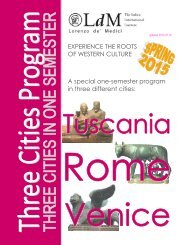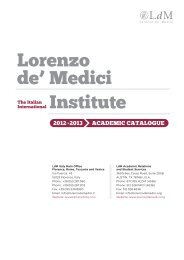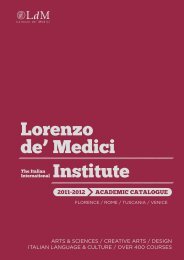aCademiC Catalog 2013-2014 - Lorenzo de Medici
aCademiC Catalog 2013-2014 - Lorenzo de Medici
aCademiC Catalog 2013-2014 - Lorenzo de Medici
Create successful ePaper yourself
Turn your PDF publications into a flip-book with our unique Google optimized e-Paper software.
School of Creative Arts FLORENCE<br />
Italian Food for Festivals and Festivities<br />
NUH 255 F<br />
Cr: 3; Contact hrs: 45<br />
In Italy food is a fundamental element of every festivity. In<br />
every region, all year round, each festa or sagra features<br />
<strong>de</strong>licious dishes, whether the event is held in honor of a saint,<br />
of a religious or secular festivity or in the spirit of the famous<br />
Italian joie <strong>de</strong> vivre. In this course all the main festivities will be<br />
analyzed through their history, religious or secular importance,<br />
and through the role they play in the local culture. All the various<br />
aspects of the Italian lifestyle will be introduced, together with<br />
the cuisine and the rituals associated with them: customs,<br />
celebrations, table manners, social gatherings and their<br />
evolution throughout the centuries. The aim of the course is to<br />
teach stu<strong>de</strong>nts to make traditional and ritual recipes of Italy:<br />
the selection of dishes reflects what is really popular in Italy<br />
and concentrates on the classics of Italian cuisine (fresh pasta,<br />
risotto, meat sauce etc.) that stu<strong>de</strong>nts can reproduce at home.<br />
Traditional food products will be also introduced, through class<br />
<strong>de</strong>monstrations and tasting.<br />
Jewish-Italian Cooking Traditions<br />
NUH 260 F<br />
Cr: 3; Contact hrs: 45<br />
The importance of the Jewish influence on certain elements of<br />
the Italian traditions in cooking and serving food is an often<br />
neglected chapter in the splendid history of Italian cuisine.<br />
The relationship between Jewish cooking traditions and the<br />
different regional Italian traditions is a rich case study because<br />
of the peculiar characteristics of such encounters. Whereas<br />
Arabs, Greeks and others have dominated a specific area of<br />
Italy at certain times, imposing their traditions and integrating<br />
them with local habits, the very ancient Jewish presence in Italy<br />
has touched almost all Italian regions and has left its mark in<br />
diverse ways. Very often the cuisine of the Italian Jews was the<br />
result of an adaptation of local ingredients and techniques to<br />
the religious restrictions of the community. At the same time,<br />
some characteristic elements of the home cuisine of migrating<br />
Jewish communities (for example from Spain or Germany)<br />
were carried to Italy and integrated into this complex culinary<br />
and cultural mixture. The purpose of this course is to analyze in<br />
a <strong>de</strong>tailed way the interrelations that contributed to the birth of<br />
a Jewish–Italian cuisine and its social, economic and historical<br />
implications.<br />
Sustainable Food<br />
NUH 280 F; Dual listed: ENV 280 F<br />
Cr: 3; Contact hrs: 45<br />
This course explores food and gastronomy in the light of<br />
environmental preservation, sustainable agricultural practices,<br />
the conservation of biological and culinary diversity and<br />
global justice. Drawing on a multi-disciplinary perspective<br />
which brings together aca<strong>de</strong>mic research and the traditional<br />
knowledge of farmers and producers, stu<strong>de</strong>nts will explore the<br />
complexity of food and food systems through an analysis of<br />
their nutritional, social, and environmental aspects. They will<br />
be encouraged to reflect on the sustainable food movement in<br />
a holistic manner, and to question the roles of individuals and<br />
consumers in today’s global food system.<br />
Dance, Music and Theatre<br />
Performance<br />
Introduction to Mo<strong>de</strong>rn Dance<br />
PER 142 F<br />
Cr: 3; Contact hrs: 45<br />
In this introductory course stu<strong>de</strong>nts study elementary mo<strong>de</strong>rn<br />
dance techniques. Emphasis is on alignment, movement<br />
through space, and the use of body weight, while a range of<br />
movement qualities are <strong>de</strong>veloped.<br />
Introduction to Ballet<br />
PER 143 F<br />
Cr: 3; Contact hrs: 45<br />
A basic course that introduces stu<strong>de</strong>nts to the study of ballet’s<br />
main concepts: correct body placement, basic positions of<br />
feet and arms, and preparation with both floor exercises and<br />
the barre. All exercises aim to shape the body into a beautiful<br />
and graceful form in or<strong>de</strong>r to enhance the stu<strong>de</strong>nt’s expressive<br />
capacity. In addition to practical classes, stu<strong>de</strong>nts will learn the<br />
history of ballet and its evolution up to the present day.<br />
Expanding Creativity<br />
PER 150 F; Dual listed: PDM 150 F / PHO 150 F / SCU 150 F<br />
Cr: 3; Contact hrs: 45<br />
Problem solving in the field of fine arts is coupling inspiration<br />
with practical solutions. Viewing the situation with an artistic<br />
eye, whether it be in drawing, painting, sculpture, graphic<br />
<strong>de</strong>sign, music or writing, the creator of the work must discover<br />
how to “put the line where he/she wants it to go”, using his/<br />
her talents to realize in a tangible form what he/she envisions<br />
in his/her imagination. The primary goal of this class will be for<br />
stu<strong>de</strong>nts to learn to express their true selves while transforming<br />
media in an artistic and mindful way. Stu<strong>de</strong>nts will learn to<br />
expand their thinking into areas of art other than their present<br />
chosen media. Since the class is ma<strong>de</strong> up of stu<strong>de</strong>nts from<br />
various artistic experiences, there is a wi<strong>de</strong> variety of outlooks<br />
to broa<strong>de</strong>n perspectives.<br />
Flamenco<br />
PER 200 F<br />
Cr: 3; Contact hrs: 45<br />
The course will cover two aspects. 1) Practical lessons on basic<br />
techniques, body posture, vueltas (turns), and zapateado<br />
(stamping of feet) plus coordination of arms and feet. Stu<strong>de</strong>nts<br />
will study the precise structure of the different rhythms, starting<br />
with Tango, the easiest Flamenco rhythms, moving on to more<br />
irregular rhythms, like slow soleares, medium alegria and the<br />
fast bulerias. The basic choreographic concepts given by the<br />
instructor will allow stu<strong>de</strong>nts to improvise and create their own<br />
choreography. 2) Historical evolution of Flamenco, from its<br />
origins up to the present day.<br />
Body Language and Communication<br />
Techniques<br />
PER 212 F; Dual listed: COM 212 F<br />
Cr: 3; Contact hrs: 45<br />
This course teaches stu<strong>de</strong>nts to use the body to achieve greater<br />
professional and social success by increasing the relational and<br />
communication capacities of every stu<strong>de</strong>nt, preparing them<br />
to enter the working world. The training is aimed at acquiring<br />
transversal expertise linked to communication, verbal and non<br />
verbal, working in groups, motivation, and body language<br />
control. The “learning by doing” methodology is very practical<br />
and involves the stu<strong>de</strong>nt in a pro-active way, through exercises<br />
and improvisation, testing individual attitu<strong>de</strong>s and personal<br />
capacities. Neutral mask and participative and creative<br />
techniques will be employed, from a theatrical approach to non<br />
verbal communication, team building, self-presentation, body<br />
language exercises, movement, and motivation, guiding each<br />
stu<strong>de</strong>nt to discover his or her strengths, and to better i<strong>de</strong>ntify<br />
the working path coherent with individual expectations and<br />
capacities.<br />
Intermediate Mo<strong>de</strong>rn Dance<br />
PER 242 F<br />
Cr: 3; Contact hrs: 45<br />
This course focuses on building stu<strong>de</strong>nts’ musicality and<br />
performance skills by exploring mo<strong>de</strong>rn dance as an art form<br />
and as a means of expression. With respect to the introductory<br />
level, techniques are reinforced and expan<strong>de</strong>d. The course<br />
reflects on the historical <strong>de</strong>velopment of mo<strong>de</strong>rn dance and<br />
mo<strong>de</strong>rn music and it emphasizes a broa<strong>de</strong>r dance vocabulary<br />
as well as more complex dance combinations. Attention is<br />
also given to analysis of a range of different mo<strong>de</strong>rn and<br />
contemporary styles (Graham, Cunningham, Horton) through<br />
vi<strong>de</strong>o projections and viewing of live performances by<br />
professional dancers, and the execution by stu<strong>de</strong>nts of more<br />
elaborate choreographies.<br />
Prerequisites: PER 142 F Introduction to Mo<strong>de</strong>rn Dance<br />
88<br />
LdM Aca<strong>de</strong>mic <strong>Catalog</strong> <strong>2013</strong>-<strong>2014</strong>





